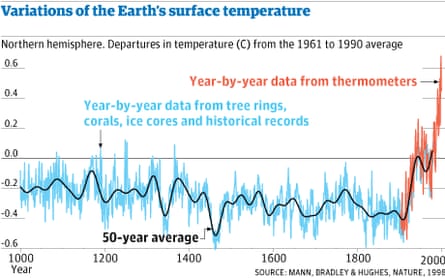
It is a persuasive image. The "hockey stick" graph shows the average global temperature over the past 1,000 years. For the first 900 years there is little variation, like the shaft of an ice-hockey stick. Then, in the 20th century, comes a sharp rise like the stick's blade.
The graph was a pioneering attempt to put together data from hundreds of studies of past temperature using "proxies" from analysing things like tree rings, lake sediments and ice cores. The resulting shape, first published by Professor Mike Mann of Pennsylvania State University in 1998, has become a symbol of the conflict between mainstream climate scientists and their critics. The deniers say it is a lie. Climate scientist stand by it.
As yet, the university has not confirmed the authenticity of the emails apparently hacked from the University of East Anglia's climatic research unit. Nevertheless the emails reveal that in 1999 there were huge rows about whether the new graph, should be given prominence in the next IPCC report due in 2001. The revelation raises questions about the transparency of the IPCC process.
On 22 September 1999, Met Office scientist Chris Folland, an IPCC lead author, alerted key researchers that a diagram of temperature change over the past thousand years "is a clear favourite for the policy makers' summary". But there were two competing graphs – Mann's hockey stick and another, by Phil Jones, Keith Briffa and others, which sought to ascertain temperatures over the past millennium using, among other things, tree rings, ice cores and coral.
Mann's graph was clearly the more compelling image of man-made climate change. Jones and Briffa's "dilutes the message rather significantly," said Folland. "We want the truth. Mike [Mann] thinks it lies nearer his result."
But Briffa did not. Three hours later, he sent a long and passionate email. "It should not be taken as read that Mike's series is THE CORRECT ONE," he warned. "I know there is pressure to present a nice tidy story as regards 'apparent unprecedented warming in a thousand years or more in the proxy data', but in reality the situation is not quite so simple... For the record, I believe that the recent warmth was probably matched about 1,000 years ago."
The row had been going on for months. Most of the correspondence is missing. But in April 1999, Ray Bradley, a co-author with Mann on the hockey stick study, was apologising for Mann's stance. "I would like to dissociate myself from Mike Mann's view [expressed in a complaint Mann had made the previous summer to the journal Science]… I find this notion quite absurd. I have worked with the UEA group for 20+ years and have great respect for them. Of course, I don't agree with everything they write, and we often have long (but cordial) arguments about what they think versus my views, but that is life… As for thinking that is it 'better that nothing appear, than something unacceptable to us'… as though we are the gatekeepers of all that is acceptable in the world of paleoclimatology seems amazingly arrogant."
Mann and Briffa eventually settled their differences. And the hockey stick was given pride of place in the IPCC report, alongside the claim that "it is likely that the 1990s have been the warmest decade and 1998 the warmest year of the millennium". Most researchers, including Briffa, now believe that statement was correct. But the emails reveal how deeply controversial it was at the time.


Comments (…)
Sign in or create your Guardian account to join the discussion